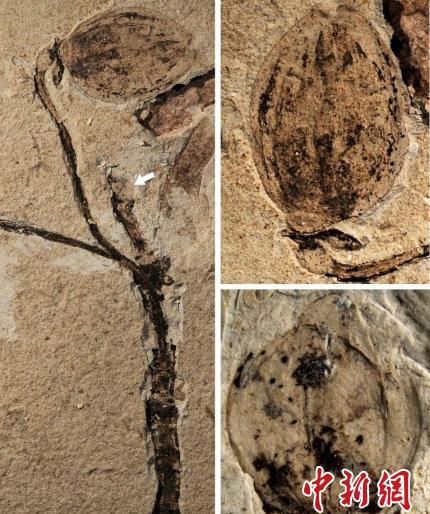
On the left, the fruit attached to the stem is a bud buried in the rock; in the upper right, the fruit connected to the stalk; in the lower right, the repaired and exposed bud. Courtesy of Nangu Institute
Nanjing, January 14 (China News Network) According to the News of the Nanjing Institute of Geology and Paleontology of the Chinese Academy of Sciences on the 14th, Wang Xin, a researcher at the Institute, and scientists from South China Agricultural University cooperated to find ancient bud fossils - Jurassic buds in the middle and late Jurassic strata of Daohugou in Ningcheng, Inner Mongolia, China. This is the world's earliest fossil record of flower buds so far.
The research has been published in the Geological Society, London, Special Publications.
In general, angiosperms can be distinguished from gymnosperms and other plants by flowers. Therefore, the relevant record of flowers is an ideal representative for studying angiosperm fossils. However, the structure of flowers is often too fragile to be preserved in the fossil record. This has also made the origin of angiosperms and flowers a point of controversy in paleobotany.
International mainstream botanists believe that the most prosperous plant group in the world is the angiosperm that began in the Early Cretaceous about 130 million years ago. However, Chinese scholars' studies of Chinese fossil materials show that this claim is debatable. This academic controversy makes it difficult to reach conclusions about many theoretical questions about the origin of angiosperms.
The researchers say the fossil exhibits the following characteristics: First, its fruit is very different from any known gymnosperm, and its buds have multiple flower covers the heart of the flower, which is almost never seen in gymnosperms.
Secondly, its fruit and buds have large contrasts in size and morphology, indicating that jurassic buds can change in morphology during development. In addition, jurassic buds have not only buds, but also directly connected fruits, branches, and traces of leaves left on the branches.
The researchers believe that the above characteristics suggest that the flowers of angiosperms were present in the Jurassic, consistent with recent advances in botanical research.
The research was supported by the Strategic Pilot Science and Technology Project of the Chinese Academy of Sciences (Category B) and the National Natural Science Foundation of China. (End)